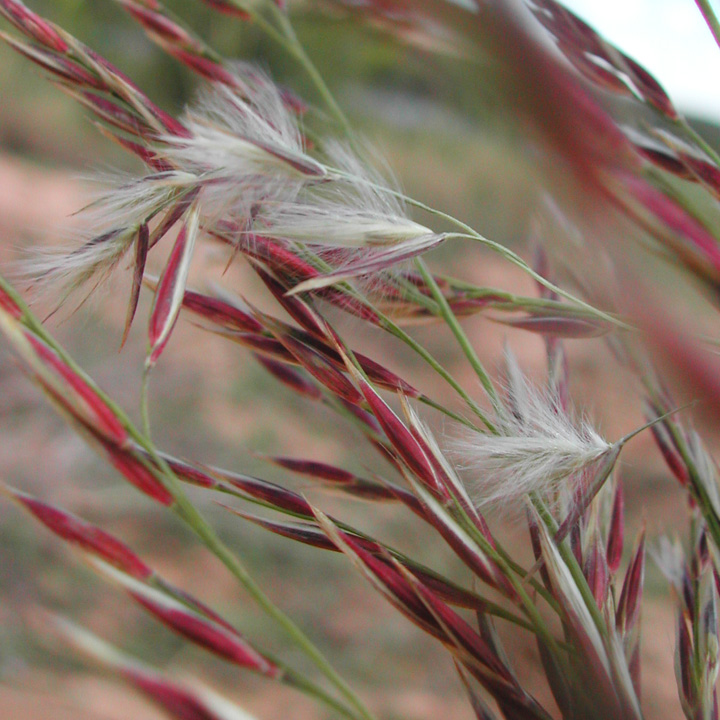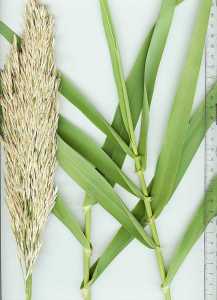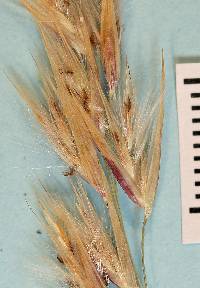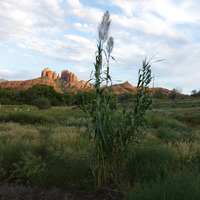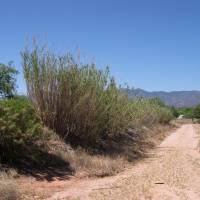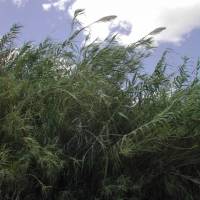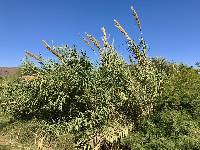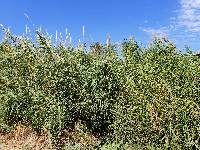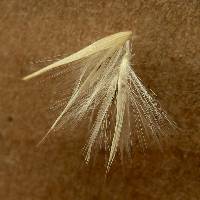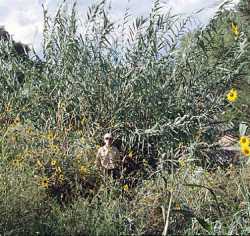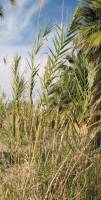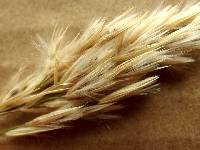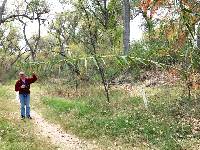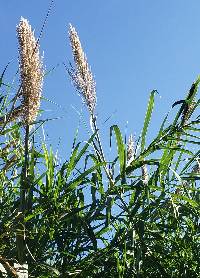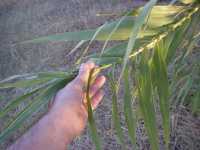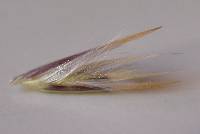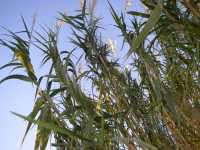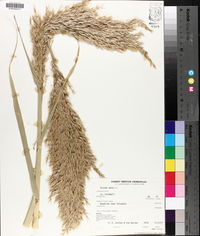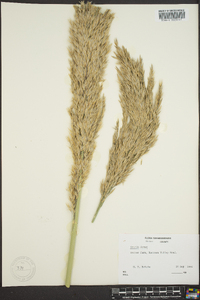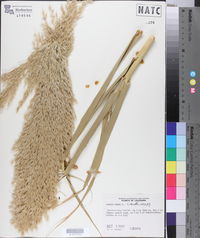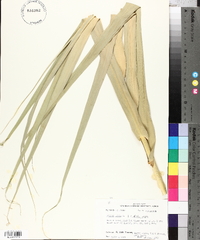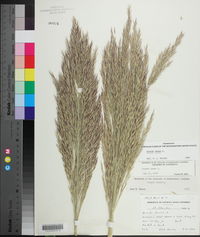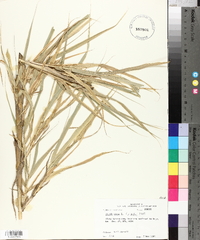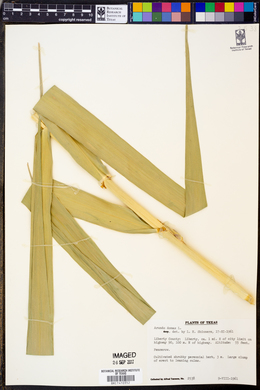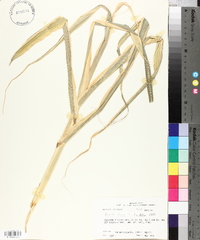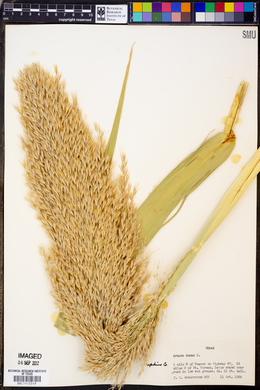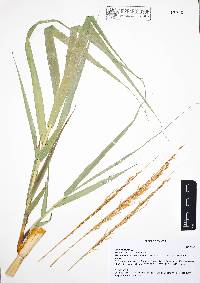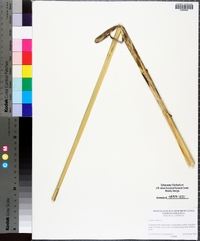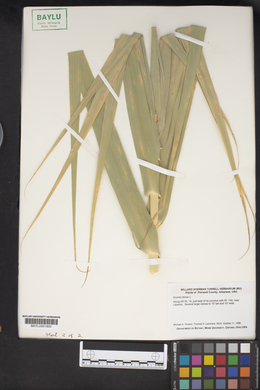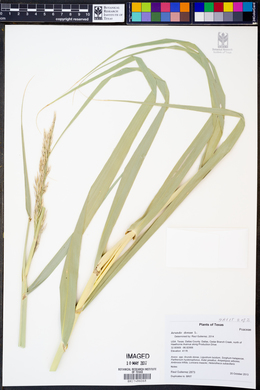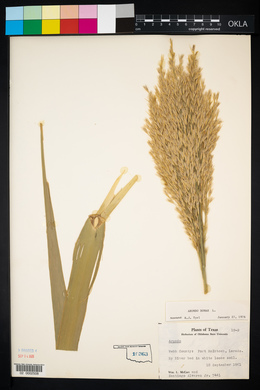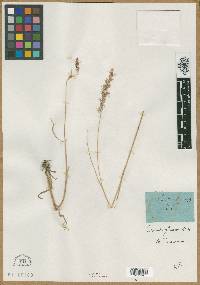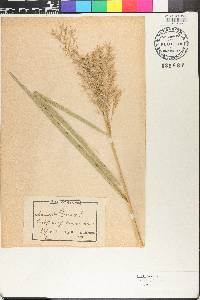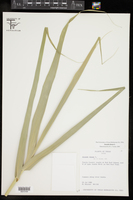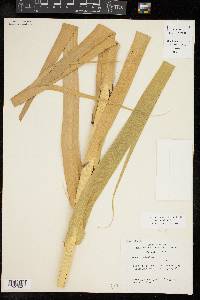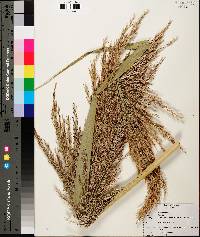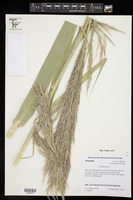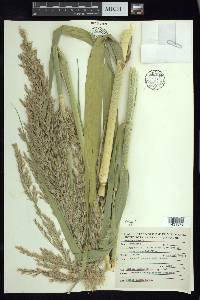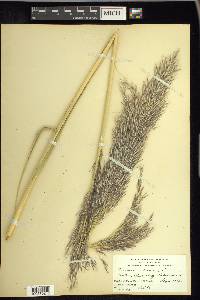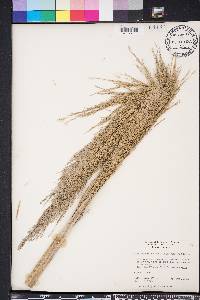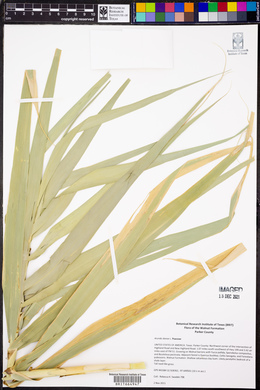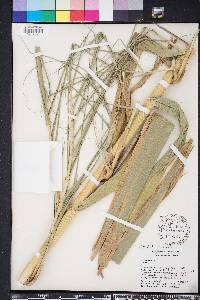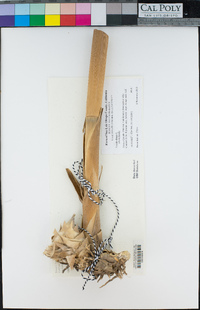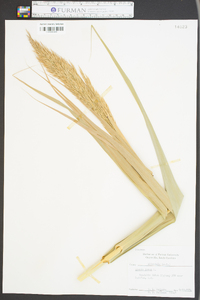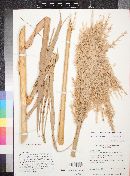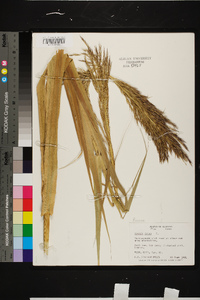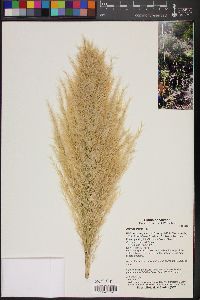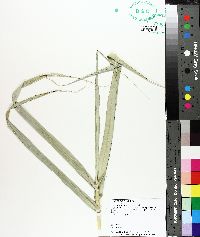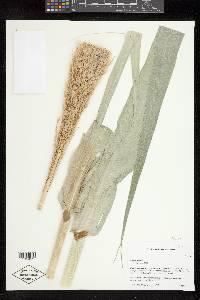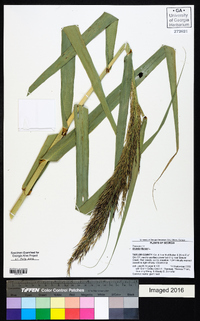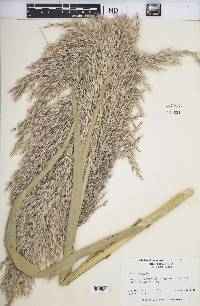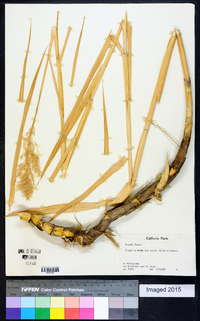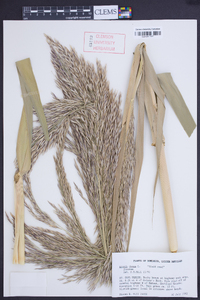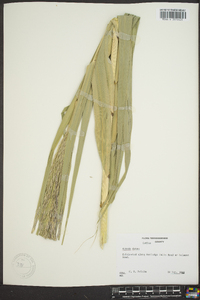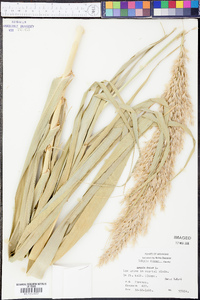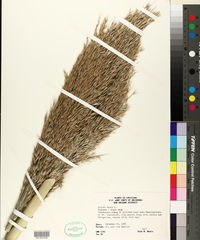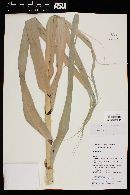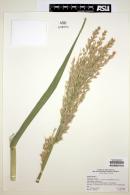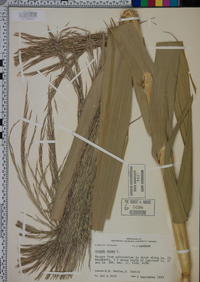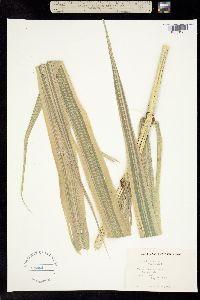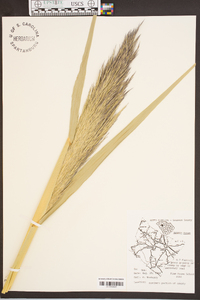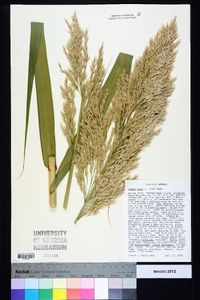Arundo donax
|
|
|
|
Family: Poaceae
giant reed, more...Giant-Reed, giant cane, giantreed (es: carrizo, cañaveral, caña)
[Arundo aegyptiaca Hort. ex Vilm., moreArundo bifaria Retz., Arundo donax var. angustifolia Döll, Arundo donax var. lanceolata Döll, Arundo donax var. versicolor (P. Mill.) Stokes, Arundo glauca Bubani, Arundo latifolia Salisb., Arundo sativa Lam., Arundo versicolor P. Mill., Cynodon donax (L.) Raspail, Donax arundinaceus , Donax donax (L.) Asch. & Graebn., Scolochloa donax (L.) Gaudin] |
Culms (2)3-10 m, in large tussocks or hedges. Leaves distichous; ligules 0.4-1 mm; blades 30-100 cm long, 2-7(9) cm wide, with a wedge-shaped, light to dark brown area at the base. Panicles 30-60 cm long, to 30 cm wide. Spikelets 10-15 mm, with 2-4 florets. Glumes subequal, as long as the spikelets, thin, brownish or purplish, 3-veined, long-acuminate; lemmas 8-12 mm, 3-5-veined, pilose, hairs 4-9 mm, apices bifid, midvein ending into a delicate awn; paleas 3-5 mm, pilose at the base; anthers 2-3 mm. Caryopses 3-4 mm, oblong, light brown. 2n = 24, 100, 110. Within the Flora region, Arundo donax grows in the southern half of the contiguous United States, being found along ditches, culverts, and roadsides where water accumulates. It has been used extensively as a windbreak, and planted for erosion control on wet dunes. It is also grown for the ornamental value of its tall, leafy culms and large panicles, but its tendency to spread is sometimes a disadvantage. Cultivars with striped or unusually wide leaves, e.g., 'Variegata' and 'Macrophylla', are of horticultural interest but do not merit taxonomic recognition. Arundo donax has been used for thousands of years in making musical instruments, the stems being used for pipes and the tough inner rind for reeds in a wide variety of woodwind instruments. It is one of the species referred to as reed in the Bible. It is still used in many parts of the world for house construction, lattice-work, mats, screens, stakes, walking sticks, and fishing poles. Dr. David Bogler, USDA NRCS PLANTS Database Perennials, Aquatic, leaves e mergent, Terrestrial, not aquatic, Rhizomes present, Rhizome short and compact, stems close, Rhizome elongate, creeping, stems distant, Stems woody, Stems nodes swollen or brittle, Stems erect or ascending, Stems caespitose, tufted, or clustered, Stems terete, round in cross section, or polygonal, Stems branching above base or distally at nodes, Stem internodes hollow, Stems with inflorescence 2-6 m tall, Stems with inflorescence 6 m or taller, Stems, culms, or scapes exceeding basal leaves, Leaves mostly cauline, Leaves conspicuously 2-ranked, distichous, Leaves sheathing at base, Leaf sheath mostly open, or loose, Leaf sheath smooth, glabrous, Leaf sheath and blade differentiated, Leaf blades disarticulating from sheath, deciduous at ligule, Leaf blades linear, Leaf blades lanceolate, Leaf blade auriculate, Leaf blades 2 or more cm wide, Leaf blades mostly flat, Leaf blades mostly glabrous, Leaf blades scabrous, roughened, or wrinkled, Ligule present, Ligule an unfringed eciliate membrane, Inflorescence terminal, Inflorescence an open panicle, openly paniculate, branches spreading, Inflorescence a contracted panicle, narrowly paniculate, branches appressed or ascending, Inflorescence solitary, with 1 spike, fascicle, glomerule, head, or cluster per stem or culm, Inflorescence branches more than 10 to numerous, Flowers bisexual, Spikelets pedicellate, Spikelets laterally compressed, Spikelet less than 3 mm wide, Spikelets with 3-7 florets, Spikelets solitary at rachis nodes, Spikelets all alike and fertille, Spikelets bisexual, Spikelets disarticulating above the glumes, glumes persistent, Spikelets disarticulating beneath or between the florets, Spikelets conspicuously hairy , Rachilla or pedicel glabrous, Glumes present, empty bracts, Glumes 2 clearly present, Glumes equal or subequal, Glumes equal to or longer than adjacent lemma, Glumes keeled or winged, Glumes 3 nerved, Glumes 4-7 nerved, Lemma similar in texture to glumes, Lemma 3 nerv ed, Lemma 5-7 nerved, Lemma body or surface hairy, Lemma apex acute or acuminate, Lemma awnless, Lemma distinctly awned, more than 2-3 mm, Lemma with 1 awn, Lemma straight, Callus or base of lemma evidently hairy, Callus hairs equal to lemma, Callus hairs longer than lemma, Palea present, well developed, Palea membranous, hyaline, Palea shorter than lemma, Palea 2 nerved or 2 keeled, Palea keels winged, scabrous, or ciliate, Stamens 3, Styles 2-fid, deeply 2-branched, Stigmas 2, Fruit - c FNA 2007, Gould 1980 Common Name: giant reed Duration: Perennial Nativity: Non-Native Lifeform: Subshrub General: Tall and mostly rhizomatous perennials, thick and knotty rhizomes; stems hard and fibrous, almost woody, mostly 2-5 m tall and 15-40 mm in diameter. Vegetative: Blades numerous, elongate, flat, glabrous or scabrous, mostly 2-6 cm broad, evenly spaced along the stem, scabrous margin. Inflorescence: Dense panicle, erect, much-branched, mostly 30-60 cm long, spikelets 10-15 mm long, three-to-six flowered, disarticulating above the glumes and between florets; glumes lanceolate, thin, three-or-five nerved, about as long the spikelet; lemmas lanceolate, mostly five-nerved, the nerves often extended as short awns, internerves membranous, back long-pilose at least on lower half, hairs mostly 6-8 mm long. Ecology: Found as an ornamental, along irrigation ditches, and on stream banks and in disturbed habitats; flowers in late summer. Distribution: Introduced to most of the southern half of the US, from CA east to MD; south through the Greater Antilles, MEX, S. and C. America; also in Africa, Europe, Asia and Australia. Notes: One of the tallest, most robust grasses in the region, reminiscent of bamboo with thick stalks from hardy rhizomes with flag leaves at obtuse to 90 degree angles from the main stalk; similar in appearance to Phragmites but distinguished by having a glabrous rachilla and a thicker auricle, with a distinct brown band (see pic). Plant introduced, can grow in saline soil, and forms thick patches along waterways. Ethnobotany: Unknown Etymology: Arundo is the Latin name for a reed grass, while donax is a Greek name for a kind of weed. Synonyms: Arundo donax var. versicolor, A. versicolor Editor: SBuckley 2010, FSCoburn 2015 |
|
|
|

